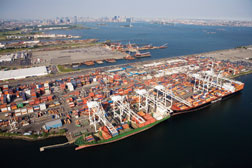
Norfolk Southern
|
Due to trends in globalization and logistics and the planned $5-billion expansion of the Panama Canal, movement of goods through the U.S. is increasing by leaps and bounds. A Government Accountability Office freight report in January estimates that total shipments of about 15 billion tons in 2004 will double by 2035.
 |
| NELSON |
Scores of projects are on the drawing boards, from Atlanta’s truck-only lanes study to Miami’s $1-billion port tunnel and everywhere in between, which aim to ease chokepoints between ports and intermodal connectors. But for many projects, funding is still questionable.
The commission’s report echoes dozens of transportation experts’ calls for intermodal planning and cooperation, and alternative modes of financing. Projects will need to do more than just expand traffic corridors. They will require a re-engineering of relationships between modes, vehicles and sources of capital.
Julie Nelson, deputy administrator of the U.S. Dept. of Transportation’s Maritime Administration, says that once goods leave a port, “you get to the other side and goods are moved by train or truck. Roads are paid for by public funds or by tolls. Trains are run by private railroads. What happens to the connectors in between? That’s where the congestion is happening.”
Numerous new reports state that freight infrastructure must become truly intermodal, as well as part of a national critical-corridor approach. “Until recently, intermodalism was a rhetorical term,” says Kenneth Orski, a veteran transportation consultant and publisher of Innovation Briefs. “The idea is taking hold because we are seeing definite benefits from using different modes for the transport of goods.”
 |
| DOWNEY |
The Alameda Corridor is an early example of how intermodal infrastructure can be built through public-private cooperation. But it was a hard-won success. Policy-wise, “we don’t have the mechanisms available to work together yet,” says Mortimer Downey, chairman of PB Consult Inc.�s Washington D.C. Office and chairman for the Coalition for America�s Gateways and Trade Corridors. “We’re not going to ask DOTs to be like railroads and trucking companies, but where there are interface facilities, we must figure out how to work together.” Downey notes that trade corridor infrastructure is well-suited for public-private partnership funding since so many private interests benefit from it. The coalition, like the commission report, advocates a value-added tax on goods movements.
So does the American Road and Transportation Builders Association, which in November released a report to Congress proposing a 25-year federal initiative that would focus exclusively on freight infrastructure, called “Critical Commerce Corridors.”
“This is the first time where we have called for a national freight program,” notes Dave Bauer, ARTBA senior vice president of government relations. ARTBA suggests new freight-related user fees such as a bill of lading tax, weight-mileage user fee, federal customs fees or tolls.

AP/Wideworld American ports will receive more traffic than ever in the next decades, burdening nation�s roads and rails.
|
Taxes and fees, of course, may be a tough sell. “Reassuring that any fees will go directly into improving the infrastructure is a great start,” says Stacey Jones, Long Beach, Calif.-based regional director with the U.K.’s Halcrow Group and a member of FuturePorts, a public-private group promoting freight infrastructure in Southern California. “The criteria will be important, as will the actual value of the fee itself. The freight fee is theoretically to be passed onto the ultimate consumer. What can the market bear?”
Until and if the commission’s sweeping recommendations are implemented, officials will continue to seek intermodal funding through existing federal programs like “Corridors of the Future” and “Projects of Regional and National Significance.” The latter has been criticized for questionable earmarks and both are limited in budget.
So officials will also seek opportunities through PPPs. Engineering firms are preparing for the trend. “Strategically, AECOM views the PPP market for goods-movement-related projects as a significant growth sector over the coming years,” says Regis Damour, president of AECOM Enterprises, New York City. Vahid Ownjazayeri, senior vice president with DMJM Harris, a unit of AECOM, adds that “we see more willingness on the part of the railroads to get involved in projects.” He cites a planned intermodal facility in Oakland, where “we’re looking at a possible PPP with the railroads.”
| + click to enlarge |
 Create Chicago Project Chicago rail expansion plan may be a prototype for future projects.
|
Workhorse Corridor
At least one Corridors of the Future-funded project hopes to use PPPs. The 1,380-mile-long, north-south Interstate 5 corridor from San Diego to the Canadian border is “a workhorse for commerce,” says Gregg Albright, deputy director of planning and modal programs for the California Dept. of Transportation. California, Oregon and Washington will get $15 million to develop ways to reduce congestion and to involve the private sector in funding construction.
The first project will focus on the Columbia River Crossing between Portland and Vancouver, Wash. The twin lift bridges carry more than 260,000 vehicles a day, with delays of up to five hours. Traffic is projected to increase by 40% over the next 20 years. Possible replacement bridges could include bus rapid transit or light rail. Travis Brouwer, federal affairs advisor for Oregon DOT, says the project could cost between $3.1 billion and $4.2 billion.
California’s wish list includes $7.7 billion for its 800 miles of I-5, says Albright. He says about $6.8 billion would be for new lanes and the rest would involve all “solutions for mobility,” including freight rail and passenger rail.
Halcrow’s Jones adds that a bond proposition in California sets aside...
he long-anticipated National Surface Transportation Policy and Revenue Study Commission’s report to Congress on Jan. 15 confirmed what transportation experts already knew: that movement of freight nationwide, including improved infrastructure, will become a policy priority.
